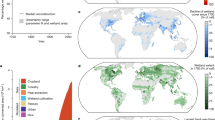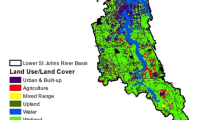Abstract
Agriculture is the greatest source of wetland loss in the Prairie Pothole Region of North and South Dakota (Dakota PPR). Demand for corn ethanol, expiration of agricultural conservation contracts, and increasing commodity prices may have stimulated alteration of wetlands for row crop production. The purpose of this study was to determine recent wetland-to-row-crop transition rates within the Dakota PPR, using GIS analysis to intersect the 2011 National Agricultural Statistics Service’s Cropland Data Layer (CDL) with wetlands mapped by the U.S. Fish & Wildlife Service’s National Wetlands Inventory (NWI) and the U.S. Geological Survey’s National Land Cover Database (NLCD). The NWI depicts wetlands as they existed in the 1980s, whereas the NLCD depicts wetlands as of 2001. On an annualized basis, the NWI wetland loss rate was 0.28 % (−5,203 ha/yr) and the NLCD wetland loss rate was 0.35 % (−6,223 ha/yr). Fewer losses occurred along the western and northern edges of the Dakota PPR, which are less conducive to row crops due to climate and topographic limitations. The map of apparent wetland losses generated by this study provides a means for monitoring and enforcement agencies to quickly identify potential violations of compliance with Swampbuster or other wetland regulations.






Similar content being viewed by others
References
Anonymous (2012) Devils Lake flood facts. North Dakota State Water Commission, Bismarck
Baker NT, Capel PD (2011) Environmental factors that influence the location of agriculture of crop agriculture in the conterminous United States. U.S. Geological Survey Scientific Investigations Report 2011–5108, Indianapolis, IN
Boryan C, Yang Z, Mueller R, Craig M (2011) Monitoring US agriculture: the US Department of Agriculture, National Agricultural Statistics Service, Cropland Data Layer Program. Geocarto Int 26:341–358
Dahl TE (2000) Status and trends of wetlands in the conterminous United States 1986 to 1997. U.S. Department of the Interior, Fish and Wildlife Service, Washington
Dahl TE (2006) Status and trends of wetlands in the conterminous United States 1998 to 2004. U.S. Department of the Interior, Fish & Wildlife Service, Washington
Dahl TE (2011) Status and trends of wetlands in the conterminous United States 2004 to 2009. U.S. Department of the Interior, Fish and Wildlife Service, Washington
Dahl TE, Johnson CE (1991) Status and trends of wetlands in the conterminous United States, mid-1970’s to mid-1980’s. U.S. Department of the Interior, Fish and Wildlife Service, Washington
Faber S, Rundquist S, Male T (2012) Plowed under: how crop subsidies contribute to massive habitat losses. Environmental Working Group, Washington
GAO (1994) Soil and wetlands conservation: Soil Conservation Service making good progress but cultural issues need attention. U.S. Government Accounting Office, Washington
GAO (2002) Agricultural conservation: survey of USDA State Technical Committee members, report to the Committee on Agriculture, Nutrition, and Forestry, U.S. Senate. U.S. Government Accounting Office, Washington
Goldstein JH, Hartmann JR (1994) The impact of federal programs on wetlands, vol. II: a report to Congress by the Secretary of the Interior. U.S. Department of the Interior, Office of Environmental Policy & Compliance, Washington
Homer C, Dewitz J, Fry J, Coan M, Hossain N, Larson C, Herold N, McKerrow A, VanDriel JN, Wickham J (2007) Completion of the 2001 National Land Cover Database for the conterminous United States. Photogramm Eng Remote Sens 73:337–341
Johnson DM, Mueller R (2010) The 2009 cropland data layer. Photogramm Eng Remote Sens 76:1201–1205
Johnson RR, Higgins KF, Kjellson ML, Elliot CR (1997) Eastern South Dakota wetlands. South Dakota State University, Brookings
Johnston CA (1998) Geographic information systems in ecology. Blackwell Science, Oxford, England
Johnston CA, Meysembourg P (2002) Comparison of the Wisconsin and National Wetlands Inventories. Wetlands 22:386–405
Karl TR (1986) The sensitivity of the Palmer Drought Severity Index and Palmer’s Z-index to their calibration coefficients including potential evapotranspiration. J Clim Appl Meteorol 25:77–86
Kudray G, Gale M (2000) Evaluation of National Wetland Inventory maps in a heavily forested region in the upper Great Lakes. Wetlands 20:581–587
Martin G, Kirkman LK, Hepinstall-Cymerman J (2012) Mapping geographically isolated wetlands in the Dougherty Plain, Georgia, USA. Wetlands 32:149–160
NCDC (2012) Plot time series. National Oceanic and Atmospheric Administration, National Climatic Data Center, Climate Services and Monitoring Division, Asheville, http://www.ncdc.noaa.gov/temp-and-precip/time-series/
NWI (2012) Download seamless wetlands data. U.S. Fish & Wildlife Service, Arlington, http://www.fws.gov/wetlands/Data/Data-Download.html
Oslund FT, Johnson RR, Hertel DR (2010) Assessing wetland changes in the Prairie Pothole Region of Minnesota from 1980 to 2007. J Fish Wildl Manag 1:131–135
Reilly J, Tubiello F, McCarl B, Abler D, Darwin R, Fuglie K, Hollinger S, Izaurralde C, Jagtap S, Jones J, Mearns L, Ojima D, Paul E, Paustian K, Riha S, Rosenberg N, Rosenzweig C (2003) U.S. agriculture and climate change: new results. Clim Chang 57:43–67
Stephens SE, Walker JA, Blunck DR, Jayaraman A, Naugle DE, Ringelman JK, Smith AJ (2008) Predicting risk of habitat conversion in native temperate grasslands. Conserv Biol 22:1320–1330
Stolt M, Baker J (1995) Evaluation of National Wetland Inventory maps to inventory wetlands in the southern Blue Ridge of Virginia. Wetlands 15:346–353
Tiner RW (1997) NWI maps: what they tell us. Natl Wetl Newsl 19:7–12
Tiner RW (2009) Status report for the National Wetlands Inventory program: 2009. U.S. Department of the Interior, Fish and Wildlife Service, Division of Habitat and Resource Conservation, Branch of Resource and Mapping Support, Arlington
U.S. EPA (1996) Ecoregions of North Dakota and South Dakota. U.S. Environmental Protection Agency, Western Ecology Division, Corvallis, http://www.epa.gov/wed/pages/ecoregions/ndsd_eco.htm
USDA NASS (2012) CropScape - cropland data layer. U.S. Department of Agriculture, National Agricultural Statistics Service, Washington, http://nassgeodata.gmu.edu/CropScape/
USDA Open Gov (2010) Conservation Reserve Program contract expirations by state for 2009–2025. U.S. Department of Agriculture, Washington, http://www.fsa.usda.gov/Internet/FSA_File/expirestate0310.xls
Wickham JD, Stehman SV, Fry JA, Smith JH, Homer CG (2010) Thematic accuracy of the NLCD 2001 land cover for the conterminous United States. Remote Sens Environ 114:1286–1296
Xian G, Homer C, Fry J (2009) Updating the 2001 National Land Cover Database land cover classification to 2006 by using landsat imagery change detection methods. Remote Sens Environ 113:1133–1147
Yu J, Belcher K (2011) An economic analysis of landowners’ willingness to adopt wetland and riparian conservation management. Can J Agric Econ Rev 59:207–222
Acknowledgments
Thanks go to two anonymous reviewers for comments that improved the quality of this manuscript.
Author information
Authors and Affiliations
Corresponding author
Rights and permissions
About this article
Cite this article
Johnston, C.A. Wetland Losses Due to Row Crop Expansion in the Dakota Prairie Pothole Region. Wetlands 33, 175–182 (2013). https://doi.org/10.1007/s13157-012-0365-x
Received:
Accepted:
Published:
Issue Date:
DOI: https://doi.org/10.1007/s13157-012-0365-x




